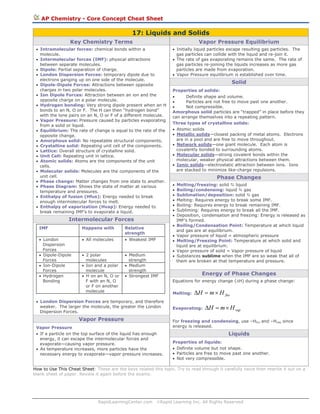
Liquidsandsolidscheatsheet 140303000945-phpapp02
- 1. RapidLearningCenter.com ©Rapid Learning Inc. All Rights Reserved AP Chemistry - Core Concept Cheat Sheet 17: Liquids and Solids Key Chemistry Terms • Intramolecular forces: chemical bonds within a molecule. • Intermolecular forces (IMF): physical attractions between separate molecules. • Dipole: Partial separation of charge. • London Dispersion Forces: temporary dipole due to electrons ganging up on one side of the molecule. • Dipole-Dipole Forces: Attractions between opposite charges in two polar molecules. • Ion Dipole Forces: Attraction between an ion and the opposite charge on a polar molecule. • Hydrogen bonding: Very strong dipole present when an H bonds to an N, O or F. The H can then “hydrogen bond” with the lone pairs on an N, O or F of a different molecule. • Vapor Pressure: Pressure caused by particles evaporating from a solid or liquid. • Equilibrium: The rate of change is equal to the rate of the opposite change. • Amorphous solid: No repeatable structural components. • Crystalline solid: Repeating unit cell of the components. • Lattice: Overall structure of crystalline solid. • Unit Cell: Repeating unit in lattice. • Atomic solids: Atoms are the components of the unit cells. • Molecular solids: Molecules are the components of the unit cell. • Phase change: Matter changes from one state to another. • Phase Diagram: Shows the state of matter at various temperature and pressures. • Enthalpy of fusion (Hfus): Energy needed to break enough intermolecular forces to melt. • Enthalpy of vaporization (Hvap): Energy needed to break remaining IMF’s to evaporate a liquid. Intermolecular Forces IMF Happens with Relative strength • London Dispersion Forces • All molecules • Weakest IMF • Dipole-Dipole Forces • 2 polar molecules • Medium strength • Ion-Dipole Forces • Ion and a polar molecule • Medium strength • Hydrogen Bonding • H on an N, O or F with an N, O or F on another molecule • Strongest IMF • London Dispersion Forces are temporary, and therefore weaker. The larger the molecule, the greater the London Dispersion Forces. Vapor Pressure Vapor Pressure • If a particle on the top surface of the liquid has enough energy, it can escape the intermolecular forces and evaporate—causing vapor pressure. • As temperature increases, more particles have the necessary energy to evaporate—vapor pressure increases. Vapor Pressure Equilibrium • Initially liquid particles escape resulting gas particles. The gas particles can collide with the liquid and re-join it. • The rate of gas evaporating remains the same. The rate of gas particles re-joining the liquids increases as more gas particles are made from evaporation. • Vapor Pressure equilibrium is established over time. Solid Properties of solids: • Definite shape and volume. • Particles are not free to move past one another. • Not compressible. Amorphous solid particles are “trapped” in place before they can arrange themselves into a repeating pattern. Three types of crystalline solids: • Atomic solids • Metallic solids—closest packing of metal atoms. Electrons are in a pool and are free to move throughout. • Network solids—one giant molecule. Each atom is covalently bonded to surrounding atoms. • Molecular solids—strong covalent bonds within the molecular, weaker physical attractions between them. • Ionic solids—electrostatic attraction between ions. Ions are stacked to minimize like-charge repulsions. Phase Changes • Melting/freezing: solid liquid • Boiling/condensing: liquid gas • Sublimation/deposition: solid gas • Melting: Requires energy to break some IMF. • Boiling: Requires energy to break remaining IMF. • Subliming: Requires energy to break all the IMF. • Deposition, condensation and freezing: Energy is released as IMF’s formed. • Boiling/Condensation Point: Temperature at which liquid and gas are at equilibrium. • Vapor pressure of liquid = atmospheric pressure • Melting/Freezing Point: Temperature at which solid and liquid are at equilibrium. • Vapor pressure of solid = Vapor pressure of liquid • Substances sublime when the IMF are so weak that all of them are broken at that temperature and pressure. Energy of Phase Changes Equations for energy change (ΔH) during a phase change: Melting: fusHmH ×=Δ Evaporating: vapHmH ×=Δ For freezing and condensing, use –Hfus and –Hvap since energy is released. Liquids Properties of liquids: • Definite volume but not shape. • Particles are free to move past one another. • Not very compressible. How to Use This Cheat Sheet: These are the keys related this topic. Try to read through it carefully twice then rewrite it out on a blank sheet of paper. Review it again before the exams.